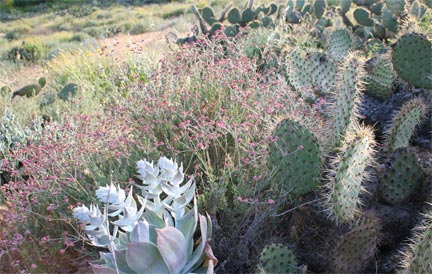Updating Our Historic Outdoors Into a 21st Century Learning Lab

By John H. Gormley, AIA, Manager of Design Services and Susan Van Atta, FASLA, Van Atta Associates
California State University Channel Islands (CI) is situated in a majestic setting that offers opportunities for students, faculty, staff, alumni and guests to experience a variety of open spaces filled with flora and fauna that relax the body, stimulate the mind and replenish the soul. This quintessentially California setting is nestled within the coastal foothills and creates a gorgeous backdrop for the historic California Mission Style architecture of the campus. The white buildings with their red tile roofs frame courtyards that offer places to experience and learn about the environment that we inhabit. But this landscape is nearly 80 years old and in need of restoration and alteration to be a “learning lab” for twenty-first century ideas on sustainability. Because of this, CI is setting out to recreate the quads, courtyards and other exterior spaces to be places for learning about the natural environment and understanding the need to replenish the resources we expend to live, learn and work here.
Built primarily during the 1930’s and ‘40’s, the campus is unique with the consistent California Mission Style architectural vocabulary of its buildings. Set at the western edge of the Santa Monica Mountains with attractive rock outcroppings supporting coastal sage and cactus scrub, the views of the mountains and coast make the campus setting inspiring to be in. Riparian trees, including Sycamores and Willows, introduce the campus along the scenic University Drive. In the natural areas of the campus many native plants, including Toyon, Lemonade berry, and Laurel Sumac, appear lush but grow naturally without irrigation. Just past the bridge over Long Grade Creek, one enters the campus core with its courtyards and quads with California Pepper, Sycamore and Jacaranda trees, cactus gardens and huge expanses of lawn.
Though engaging and spectacular, the campus landscape needs to be updated. CI presents an opportunity to develop a landscape that emphasizes the best qualities of the existing natural and cultural landscape. As an example, regionally native plants may be used in the landscape, and early California and agrarian landscape themes will reinforce the sense of place. Renovation of the landscape offers the opportunity to use resources wisely while creating spaces that foster learning within and across disciplines about this place and how we interact within it. Some of the ways that the landscape can improve on our resource management include the following:
- decreased water use for irrigation,
- improved water quality and conservation techniques (bioswales, rainwater gardens and cisterns),
- energy savings as a result of planting for climate control,
- plant selection to avoid the need for pesticides and fertilizers,
- plant placement to minimize pruning and shaping,
- planning for onsite composting to replenish the soils and avoid landfill expenses.
All of these lead to a healthier landscape with less use of natural resources, lower maintenance efforts and expenditures.
An attractive, healthy, and regenerative landscape will attract the best students, faculty, and staff. With our ideal climate, informal gathering areas can easily be provided in the landscape to support the multicultural, international, integrative and civic engagement pillars of the academic program. A vital and interesting landscape can be a valuable learning tool for a campus that emphasizes experiential learning. An updated landscape can be designed to serve as outdoor laboratories and provide many interactive learning experiences. The courtyards, gardens, quads and natural landscapes can serve as outdoor rooms, classrooms and offices in Camarillo’s pleasant climate.
The University is committed to maintaining a sustainable campus, which means it strives to implement environmentally aware programs and preserve its beautiful surroundings. The easiest and most cost effective way to emphasize these values is to design sensitively a landscape that integrates these values.
